-
Catalogue of products
-
- Sale
-
Silver jewellery
-
All in the category Silver jewellery
- Pendants
- Bracelets
- Rings
- Earrings
- Moldavites, czech
- Necklaces
- Golden jewellery
- Torcs - necklaces
- Amber jewelry
- Jewellery sets
- Brooches and buckles
- Silver and stones, jewels
-
Thematic jewelry collections
-
 All in the category Thematic jewelry collections
All in the category Thematic jewelry collections
- Lapponia jewellry
- VIKINGS - bracelets
- Art nouveau jewelry
- Dinosaur pendants
- Mythology collection, ancient cultures
- Nautical silver jewelry
- Filigree and granulated replica jewels
- Garnet jewelry - czech made
- Mystica silver collection - pendants
- Mystica silver collection - earrings
- Mystica collection - silver necklaces
- Historical jewelry
- Zodiac, silver pendants
- Viking jewelry
- Pendants - Historia
-
-
-
Jewellery - bronze, zinc
-
All in the category Jewellery - bronze, zinc
- Amulets and talismans
- Bronze and brass replicas - jewellery
- Gilded jewelry
- Cords, boxes, chains
- Forged jewelry, torcs, bracelets
- Costume jewellery
- Keychains
- Fantasy jewels
- Crowns and tiaras
- Bronze historical jewels
- Chakra, reiki
- Celtic brass jewels, import from Ireland
- Badges, historic jewels
- Scottish clan badges
- Original celtic jewelry
-
-
Replicas - Swords, Axes, Knives
-
All in the category Replicas - Swords, Axes, Knives
- Sharp Blades - throwing knives
- Swords
- Axes, poleweapons
- Daggers
- Knives
- FakeSteel armory
- Maces, war hammers
- Saex knives, scramasax
- Lances, spears
- Archery
- Damascus steel knives
- Falchions and Lange Messers
- Swiss army knives
- HMB - swords, falchions, axes, weapons
- Firearms, cannons
- Viking knives
- Hunting hangers
- Wooden swords and armour
- Knives - accessories, sharpeners
- Kitchen knives
-
-
Armour Helmets, Shields
-
T-shirts, Boots
-
Ceramics, Glass
-
Leather Products
-
All in the category Leather Products
- Belts
- Bags, sporrans
- Belt accessories
- Hair clips, accessories, jewellery
- Wallets
- Wristbands
- Leather stamps
- Leather material, furs
- Custom made belts
- Leather masks
- Bottles, hip flasks
- Keychains, whips, other
- Leather care, dyes and stains
- Historical shoemaking
- Leathercraft tools
- Riding shop - horse saddles
- Falconry
- Furs, Reindeer Skins
-
-
Horn Products
-
Smithy Works, Coins
-
Bushcraft, Living History, Crafts
-
All in the category Bushcraft, Living History, Crafts
- Bushcraft
- Forged carving chisels
- Kuksa - Finnish dishes
- Leather, furs, skins, pergamens
- Europe
- Drugstore
- Historical glass beads, replica
- Rocailles Czech glass beads
- Deer antler products
- Craftsman tools, acessory
- Prehistoric ages
- Native americans
- Old Slavs
-
-
 Coins
Coins
-
Shoes, Costumes
-
Drums, Flutes
-
Woolen products, Ireland
-
 Wood
Wood
-
Licensed Merch - films, games
-
All in the category Licensed Merch - films, games
- Warhammer 40K
- 2001 Space Odyssey
- AC/DC
- Alien
- Antman
- Assassin's Creed
- Asterix
- Avatar
- Avengers - Infinity War
- Back to the Future
- Batman
- Beetlejuice
- Big Bang Theory
- Blade Runner
- Bud Spencer - Terence Hill
- CBGBs
- Clockwork Orange
- Deadpool
- Deep Purple
- E.T. the Extra-Terrestrial
- Frank Zappa
- FULL METAL JACKET
- GAME OF THRONES
- Ghostbusters
- Godfather
- Gremlins
- GUARDIANS OF THE GALAXY
- HAN SOLO MOVIE
- Harry Potter
- Iron Maiden
- IT
- Jaws
- James Bond 007
- Jurassic Park
- King Kong
- Knight Rider
- KISS
- Led Zeppelin
- LOONEY TUNES
- LORD OF THE RING
- Magic the Gathering
- Marvel
- VIKINGS
- Metallica
- Metro Exodus
- Mortal Kombat
- Mr Pickles
- NASA
- Nirvana
- Peaky Blinders
- Pearl Jam
- Pink Floyd
- Planet of the Apes - Planeta opic
- Pokémon
- Predator
- Queen
- Rambo
- Rick and Morty
- Robocop
- Spiderman
- Star Wars
- Suicide Squad
- Superman
- Teenage Mutant Ninja Turtles - Želvy ninja
- The Doors
- The Witcher
- Thor Ragnarok
- Vikings
- World of Warcraft
- Rocky
- Terminator
- Dračí Hlídka
-
-
Hry a knihy
-
Home decor
-
Historical Tents
-
 Mead, Honey
Mead, Honey
-
 Moldavites, minerals, fossils
Moldavites, minerals, fossils
-
Cosmetics
-
Archeology, Geology
-
Interior design
-
 Yule decorations, Glass Beads
Yule decorations, Glass Beads
-
FILM and props
-
 Outdoor - Bushcraft
Outdoor - Bushcraft
- Naav
- Arma Epona
- WHOLESALE lots
- Gift Certificates
- SPECIAL OFFER, discounts
-
- Log in
- Create an account
- Wholesale
- Contact us
- Country (English)
- Currency ($ - USD)


Nothing was added in your basket.
- Blog
- Arms and Armour
- The Story of the Sallet
The Story of the Sallet

A part of the European protective armor of the late Middle Ages was a type of helmet known as the sallet. Depending on the place of origin, the path of development, and the design, the so-called German and Italian sallets are usually distinguished, with the German one being somewhat more fixed in general awareness. And how did the story of this type of helmet, which is literally iconic for the European late Middle Ages, unfold?

Development of the German and Italian sallet from the bascinet helmet. Drawing by J. Biederman.
The common origin lies in an early form of helmet called the basinet in the first quarter of the 14th century. During further development of „proto-sallet“, when the rear part of this helmet was elongated, a new type was separated around the last quarter of the 14th century. This type shortened the rear part again and at the same time adapted more to the anatomy of the head and neck - this was the predecessor of the true Italian sallet. The second type of „proto-sallet“, on the other hand, elongated the rear part and extended the metal plate in the forehead area down towards the facial part, which necessitated the creation of a visor, thus creating the first German sallets. At the same time, from this second type of „proto-sallet“, a new type of helmet with a plate folded like hat brim on all sides separated. Thus becoming the precursor of one group of iron hats. It is also likely that at least the development of iron hats and German sallets mutually influenced each other from the beginning of the 15th century.
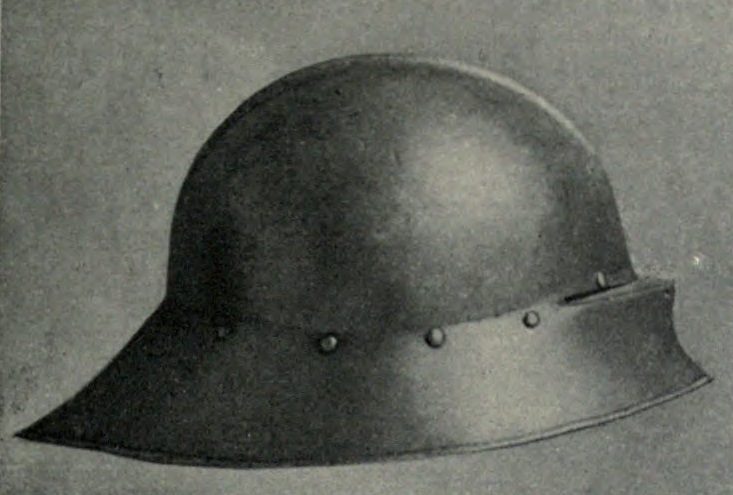
Early type of German sallet with a fixed visor, circa 1450. LAKING, Guy Francis: A record of European armour and arms through seven centuries. Vol. 2. London G. Bell and Sons, 1920, p. 27.
Around the second half of the 14th century, some iron hats began to tilt the hat brim more, allowing for better deflection and slipping of blows directed at the head. However, such a tilt of the brim began to obstruct the wearer's view, so at the end of the 14th and beginning of the 15th centuries, some hats were cut out at eye level, leaving the segment between them as a raised nasal (sometimes slightly extended). In other hats of this design, the brim was not cut, but it was addressed by punching one slit-like visor (or two smaller ones) directly in the brim. And it is precisely this design in some specimens from German-speaking countries beyond the Alps that strongly resembles the German sallet - in it, the imaginary brim tilted more to the sides and was more protruding forward in the front part. Finally, the German sallet elongated the rear part, which was as elegant as it was practical, as this modified helmet protected the nape and neck better than an iron hat. These changes occurred sometime in the second quarter of the 15th century, and the first typically shaped German sallets began to appear in European military equipment between approximately 1420-1440. At that time, they still had fixed visor with an eye-slit, but shortly afterward, sallets with movable visors began to be produced.
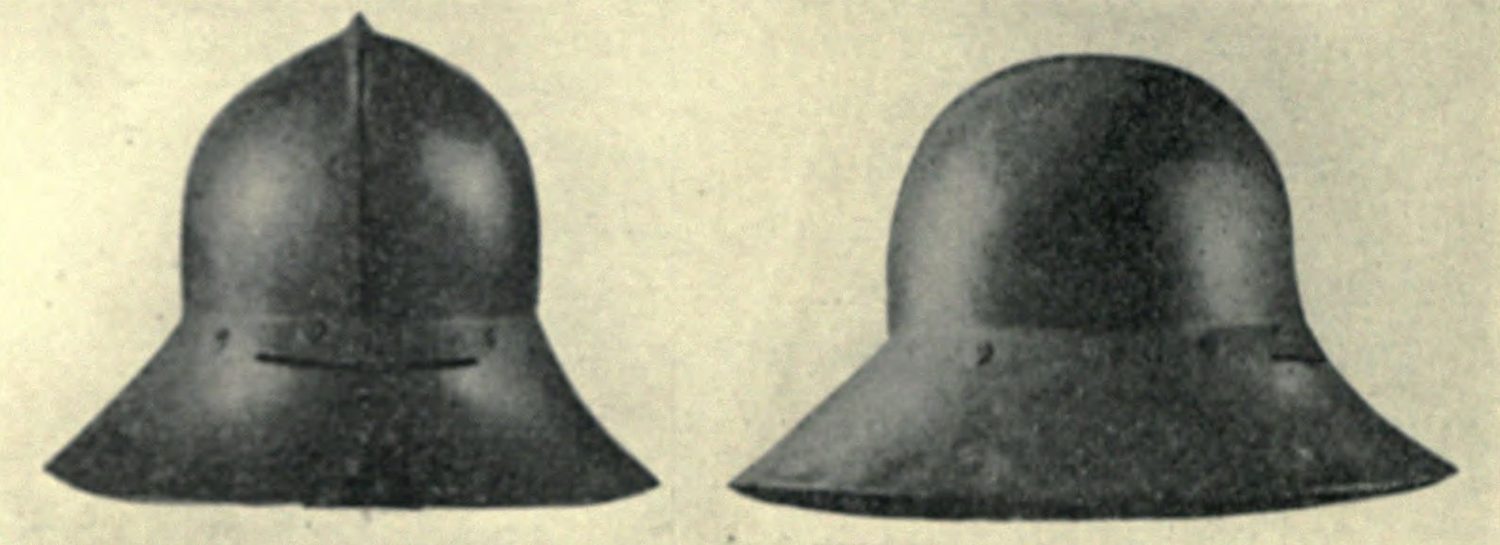
German sallet resembling an iron hat, circa 1460. LAKING, Guy Francis: A record of European armour and arms through seven centuries. Vol. 2. London G. Bell and Sons, 1920, p. 4.
German sallets were worn by both cavalrymen and infantrymen, with infantrymen (or dismounted heavy cavalrymen) often wearing them further back on the head like an iron hat, so they did not look through the eye slits but under the edge of the visor. The helmet, which excellently protected the head, nape, and rear part of the neck, however, left the lower part of the face and neck partially exposed. This problem was solved by wearing a mail collar, or a plate protection of the throat, chin, and mouth, known as a plate chin guard or bevor.
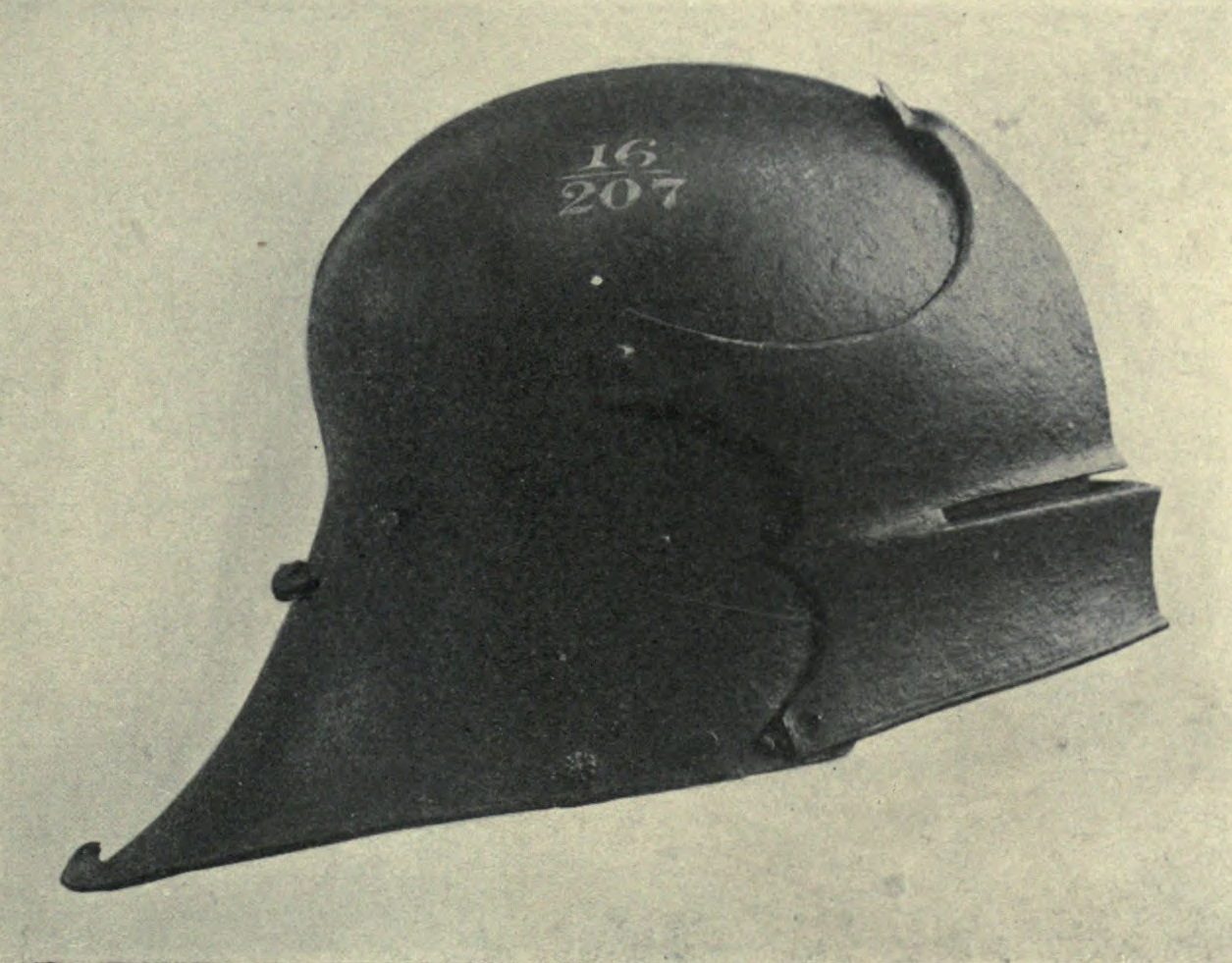
German salletwith a movable visor, second half of the 15th century. LAKING, Guy Francis: A record of European armour and arms through seven centuries. Vol. 2. London G. Bell and Sons, 1920, p. 29.
Equally interesting is the story of the second type, the so-called Italian sallet. Some helmets with this designation in shape remotely resemble the German sallet and since they are usually dated to the 15th century, they are sometimes considered Italian adaptations of the German prototype. On the other hand, however, there undoubtedly existed a sallet that originated in an Italian environment. This happened roughly at the same time as beyond the Alps, from the last quarter of the 14th century to the beginning of the 15th century. As mentioned earlier, the Italian sallet evolved directly from the basinet helmet, and unlike the German version of this helmet, there can be no talk of any connection with an iron hat. Unlike the original basinet, the Italian sallet had a rounded top of the bell, which could (but did not have to) be divided by a crest in the axis of the forehead-neck, and the bottom of the rear part was slightly curved and elegantly pulled out. Like the German sallet, the Italian sallet effectively protected the head and the rear part of the neck but left the face completely exposed, making it suitable to combine again with a mail collar or a plate bevor. It was therefore a more suitable helmet for infantry, although its wear was not prevented by cavalrymen. From the Italian sallet, a type of helmet called a barbute evolved, which had a better-covered face and resembled the ancient helmets of Greek hoplites.

Northern Italian sallet, somewhat resembling the German one. Circa 1480. LAKING, Guy Francis: A record of European armour and arms through seven centuries. Vol. 2. London G. Bell and Sons, 1920, p. 30.
The German sallet spread relatively quickly across Europe, becoming a generally popular helmet for the next 60 years and served until the first decade of the 16th century. Its Italian counterpart was more popular in the south and also in the west of Europe, so there was only an approximate boundary between the popularity of both types of sallets in Europe.

In the middle, Italian sallet (circa 1480), on the sides Italian sallets or rather barbutes (circa 1470). LAKING, Guy Francis: A record of European armour and arms through seven centuries. Vol. 2. London G. Bell and Sons, 1920, p. 19.
It might seem that with the decline of both types of sallets from the scene in the first quarter of the 16th century, the story of this type of helmet came to a close. At least the German sallet had not yet said its figurative last word because this helmet, due to the practicality of its shape, was an inspiration for the shapes of steel helmets used by the Central Powers during World War I - in the German army under the designation M1916 and in the Austro-Hungarian army as M1917. This helmet shape was also used in the German arsenal during World War II, and through export, it spread to other parts of the world in the first half of the 20th century. The last chapter in the inspiration of the sallet is represented by modern Kevlar helmets such as the MICH or LWH (originally also PAGST), which strongly resemble this late medieval helmet to this day.
And what to read next?
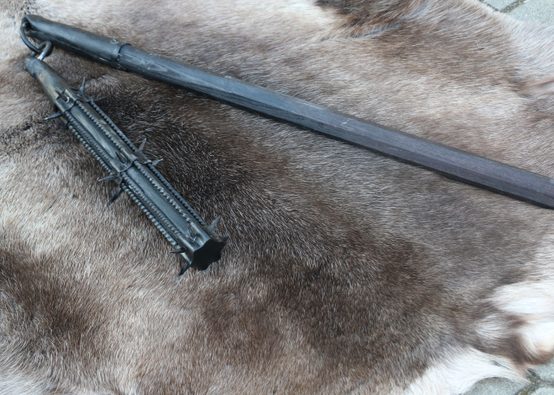
Military Flail
The flail as an agricultural tool has been known since the…
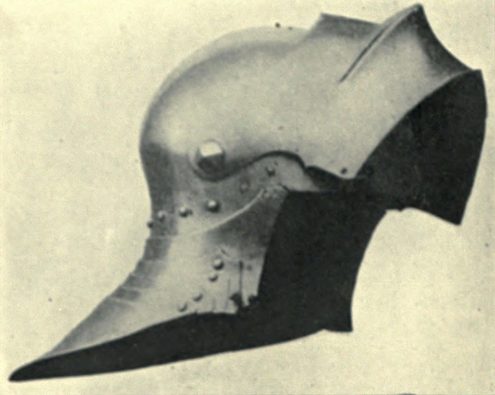
The Story of the Sallet
A part of the European protective armor of the late Middle…
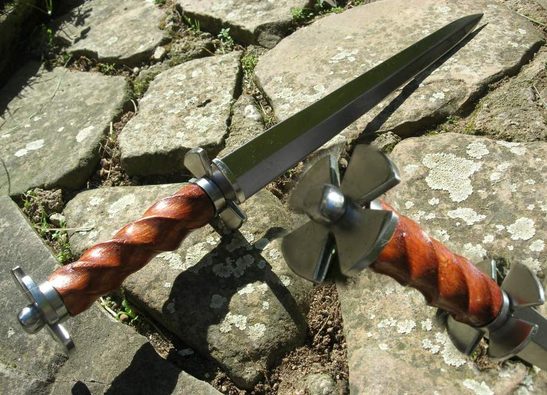
Rondel Dagger
When it comes to short sidearms of the late Middle Ages, it…
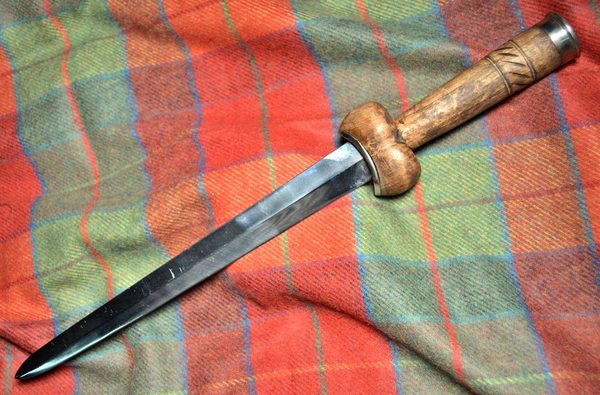
Kidney dagger – Bollock Dagger
The dagger was, alongside the knife, a basic and usually…


